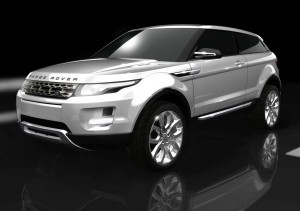
Land Rover will turn the LRX concept into a 2011 Range Rover that it promises will be the smallest, lightest vehicle it has ever produced.
Land Rover is confirming plans to put the well-received LRX concept vehicle into production, with its expected to reach showrooms, sometime in 2011, as the third model in the premium Range Rover line-up.
Smaller and more fuel-efficient than the other two models, the launch of the LRX is designed to not only expand the appeal of the overall Land Rover brand, but shift it towards a “greener and (more) sustainable” business model, company officials declared, earlier today.
Like all sport-utility vehicle manufacturers, Land Rover has seen a significant shift in public attitude, in recent years. Though the basic utility of SUVs may still appeal, consumers are seeking better mileage and lower emissions, demands also being made by regulators in the U.S., Europe and other key markets.
The LRX appears to be just one of the new models coming from Land Rover headquarters, in Gaydon, the automaker hinting that there will be “a new and expanded range of products and environmental technology, delivered through streamlined and competitive costs and a new manufacturing strategy.”
Adding further impetus, Land Rover is under significant pressure from its new owner, India’s Tata Motors – which also purchased Jaguar Cars – to start delivering a positive financial return. That hasn’t been easy considering the impact the current auto market has had on sales.
“This is a plan that recognizes the impact the economic collapse has had on our business,” declared Jaguar Land Rover Chief Executive Officer, David Smith, “and at the same time the opportunities that lie ahead for these two great brands. We are confident that a new more efficient and competitive structure combined with future investment will unlock the true potential of this business.”
Though the production version of the LRX will carry a Range Rover nameplate – normally reserved for Land Rover’s flagship products – the automaker hints that it will be the smallest, lightest and most fuel-efficient vehicle it has ever produced. First unveiled at the Detroit Auto Show, in January 2008, the prototype was also heralded as the most sporty design ever developed by Land Rover.
At the Motor City preview, company officials noted they were working on an unusual hybrid version of LRX, a sort of through-the-road hybrid, with one set of wheels powered by a conventional, internal combustion engine, the other by a battery-powered motor. Dubbed ERAD, for Electric Rear Axle Drive, it could yield as much as 60 mpg.
While Land Rover officials aren’t providing any technical details, design director Gerry McGovern did note that, on the styling front, the production version of LRX “will be true to the concept and have many recognizable Range Rover design cues including the signature clamshell bonnet, the floating roof and the solid ‘wheel-at-each-corner’ stance.”
Can the LRX/Range Rover turn things around? Land Rover and Tata can only hope. Along with Jaguar, the SUV maker has seen its sales tumble by nearly a third, and that has forced it to pull 100,000 units out of its production plans – leaving its assembly operations grossly underutilized. Spending has been slashed and 2,500 employees have, as the Brits like to say, been made redundant.
Even then, company officials acknowledge, they have seen their balance sheet swing from a comfortable profit, in 2007, to “significant losses over the last 12 months,” something that they admit is not sustainable.
With Jaguar and Land Rover closely integrated, all future plans will have to address the two brands together, to varying degrees. And both are looking to upgrade both products and their manufacturing operations. Like all luxury marques, both face a particular challenge maintaining their premium position as the industry downsizes and migrates toward battery-powered drivetrain technology.
With the assistance of European Investment Bank funding, JLR is pumping about $1.5 billion into environmental-focused technology.
But some more traditional strategies will be resorted to, as well. Among other things, that means cutting back from two assembly plants to one, notes a JLR release, “by the middle of the next decade.” The Indian-owned company is also seeking to restructure pensions and create a multi-tiered wage structure. Such steps are generating strong push-back from British unions. But company officials insist that without such steps – and without new products like LRX – they simply won’t be able to regain a competitive stance.
